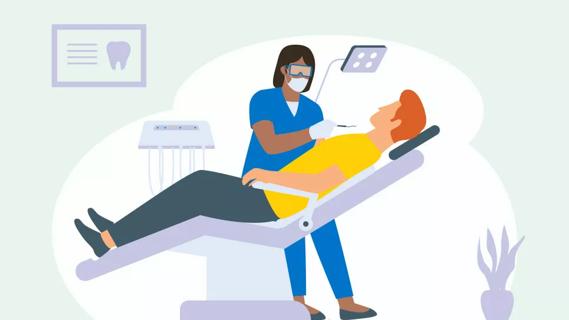Spinal blocks provide complete numbing for shorter periods, while epidurals can allow for some feeling

Spinal blocks and epidurals both help manage pain. But they work in different ways, and the differences matter.
Advertisement
Cleveland Clinic is a non-profit academic medical center. Advertising on our site helps support our mission. We do not endorse non-Cleveland Clinic products or services. Policy
Whether you’re getting surgery, going into labor or dealing with chronic back pain, the right choice depends on your body and goals.
Anesthesiologist and pain management specialist Kristin Powers, MD, explains.
Spinal blocks (also called spinal anesthesia) and epidurals are two kinds of anesthesia delivered through your back. One key difference is the intended goal.
“There are several things to consider,” Dr. Powers notes. “If the goal is for surgical anesthesia or labor, you’re typically going to consider a spinal block or epidural catheter. If the goal is outpatient chronic pain relief, usually you will do an epidural injection, without a catheter.”
Epidural anesthesia is commonly used for pain relief during labor. That’s because an epidural helps lower the intensity of contractions while still allowing you to push. And because it can be dosed repeatedly, it can last through the course of a long labor and delivery.
Advertisement
If things change and you need a C-section, your care team can up the dosage on the epidural so you go very numb. That will make your lower half completely numb and keep you from moving on the table.
But if the plan was for a C-section from the get-go, you’ll most commonly be given a spinal block at the start.
Spinal anesthesia is a type of anesthesia used in surgeries when your care team doesn’t want you to be able to move or feel anything from the belly button down. It’s also sometimes called a “spinal.”
When you have a spinal block, your provider injects numbing medication into a fluid-filled space in your lower spine called the intrathecal or subarachnoid space. That’s below the end of your spinal cord, where the root nerves of your spinal cord are.
Those nerves float in cerebrospinal fluid (CSF). During a spinal block, medication is injected into the CSF, and you go numb.
“We put a needle into the cerebrospinal fluid and give very dense medicine to achieve complete numbness — so much so that you can have surgery and not feel it,” Dr. Powers describes.
Spinal blocks are ideal when a quick, predictable and highly effective anesthetic is needed for a limited period.
“Depending on the medication used, spinal anesthesia will usually last about one to three hours,” Dr. Powers says.
That can make a spinal block a good solution for procedures like:
Epidurals are also placed in your back, but they go in a slightly different space. They’re inserted in the epidural space (hence the name), not the intrathecal space.
Unlike spinal blocks, which are a single injection, some epidurals use a catheter. That means the medication flows through a thin tube inserted in your back. That allows the team to give you more or different medications if needed.
Epidurals can be placed in your lower back, like a spinal block, to relieve pain below your belly button. But they can also be used higher up in your spine to provide pain relief to different areas of your body.
“You can think of an epidural as just a space where we put medicine, but depending on the objective, we modify what we do,” Dr. Powers explains.
Epidurals are synonymous with pain relief during labor and delivery. That is one use — but it’s not the only one.
Epidural injections (like steroid injections) are commonly used in outpatient chronic pain management for things like back or leg pain. Epidural anesthesia can also be used after surgery to lower pain and prevent complications.
Advertisement
“We use thoracic epidurals after chest surgery to help patients breathe deeply and lower their risk of pneumonia, for example,” Dr. Power points out.
Epidurals and spinal blocks each have their own uses. So, asking which is better is like asking if a hammer is better than a wrench. They each do a different job. One may be better than the other depending on the goal.
“We’re not choosing a method based on which is better overall. It’s about what your goal is: surgical numbness or pain control. Then, we tailor the medicine to that,” Dr. Powers confirms.
If you’re having a procedure and are wondering about your pain management options, talk with your healthcare team. They can help you understand the recommended pain management techniques and how they work.
Advertisement
Learn more about our editorial process.
Advertisement

Epidurals can help with the discomforts of labor and delivery — but whether you want one is entirely your choice

Advances in technology and medications have made the process safer than ever

If you have naturally red hair, feeling the pain may be in your DNA

The numbness and tingling should wear off in about two hours

Try seated and standing exercises to help lengthen and strengthen the muscles that support your plantar fascia

This medication is best used on a limited basis

Sensory deprivation therapy can help relieve stress, improve sleep and decrease physical pain

Acute pain goes away with treatment, while chronic pain is long-lasting and can be complex to manage

Babies can get congested easily, but you can calm their cough by keeping them hydrated, using nasal drops and running a humidifier

Weight loss may cause loose, sagging skin and muscle loss to your rear

Several conditions, like vitiligo and fungal infection, can cause a loss of pigmentation, leading to white spots or patches on your skin